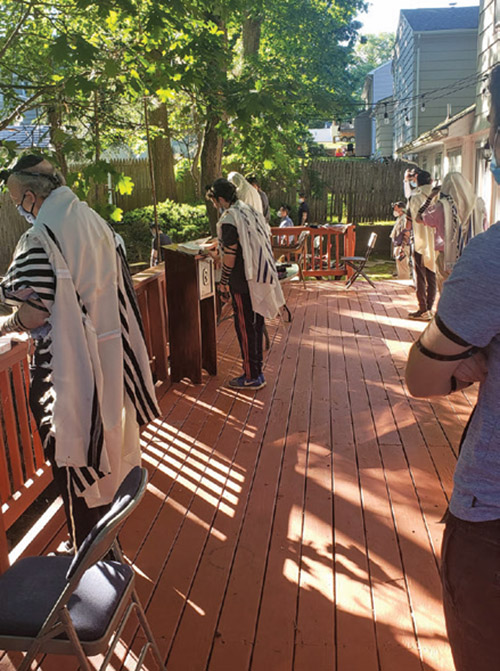

You may say you are devoted to davening with a minyan, whenever possible.
You may say that you understand the best advice of the CDC and public health officials and you know that davening outside is always preferable.
But how committed are you to embracing both ideals when the weather gets downright difficult?
The leaders and participants of two outdoor minyanim in North Jersey are truly dedicated to both values and plan to persevere, no matter what.
The Regent Street minyan in Bergenfield, nicknamed the Ohel Leah minyan (after organizer Shimmy Stein’s wife), is committed to continue davening outside through the winter months. As Stein explained, the minyan formed in early June and met through mid-October in his backyard on Regent Street, with the backyard of their next door neighbors, Leah and Reuven Escott, serving as their ezras nashim. The minyan later moved to a neighbor’s home, Rachel and Menachem Schechter on Westminster Avenue, where it plans to stay. The ezras nashim is now located in the backyard of their neighbors, Esther and Neal Crystal.
With the help of the nearby shul, Congregation Beth Abraham in Bergenfield, where most Ohel Leah attendees are members, the outdoor minyan offered services on the chagim, attracting 74 people on Rosh Hashanah and 64 on Yom Kippur.
Stein has served as gabbai of the hashkama minyan at Beth Abraham for 28 years and as a gabbai in that and other minyanim for nearly 50 years, so he is very comfortable in the role of organizer of the Ohel Leah outside minyan. But he is not alone in getting things done. He asserts: “What makes this minyan work is that everyone steps up to lain, daven and make sure we have a minyan.”
The minyan has 30 people in its WhatsApp group and can attract up to 40 people on a Shabbat morning, with 20 or so attending on weekday mornings. As the weather has gotten colder, 10 to 12 core members reliably show up for Shacharit and roughly 14 for Mincha and Maariv. They are a hearty bunch and refer to themselves as the “umbrella minyan” for the times they’ve davened outside despite a downpour. They’ve only canceled davening a handful of times, due to lightning or strong winds.
The Ohel Leah minyan is dedicated to keep going. As Stein said, “I’m 64 and I’m not looking to daven inside anytime soon [due to COVID-19]. And others feel the same way.” He added that he and the others do “very much look forward to returning to shul,” but plan to keep the minyan going “until the virus is under control, to the point where everyone is comfortable going indoors.”
Farther down the Garden State Parkway, the Redwood Minyan in West Orange (near the border with Verona) also plans to remain throughout the winter. To be fair, though, this minyan had a giant head start in organizing itself. The Redwood Minyan had already been meeting for 15 years. It existed “before,” as largely a Friday night and sometimes Shabbat Mincha minyan for people in the neighborhood. The minyan had a loyal following, with its own WhatsApp group, so it was no huge leap to form a regular outdoor minyan when meeting in a shul building was discouraged due to COVID-19.
Organizers Moshe Glick, Howie Berg, Ari Tarzik and Tuvia Kimmel adapted the minyan to meet regularly, and they held services first on the Glicks’ back deck and later in the Bergs’ paved driveway, under tents, where it remains. The minyan met regularly through September, holding three services a day. When services in shuls became more regular, the Redwood Minyan transitioned to meeting Friday nights, Saturday nights and Sunday mornings.
Over the chagim, the Redwood Minyan worked cooperatively with the two nearby shuls—Congregation Ahawas Achim B’nai Jacob and David, and Congregation Ohr Torah—to offer a full array of outdoor services that would appeal to members of both shuls. The Redwood Minyan formed a few committees to handle all the details and capped attendance at 60 per service to allow for proper social distancing. The minyan charged $100 per participating family and gave all funds in excess of expenses to the two shuls. They also raised money from kibbudim, about $7,000-$8,000, which was paid directly by the donors to the local shuls or the charity of their choice.
The Redwood Minyan continues to meet on weekends and attracts 15-20 participants to each service. They plan to keep going, no matter what winter dishes out. And they’ve prepared for the worst: They’ve got tents and have acquired heaters to make things manageable. They’ve also enlisted Mohamed, a non-Jewish neighbor, to turn the heaters on before services and off after davening is done on Shabbat.
By Harry Glazer
�













